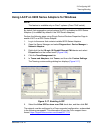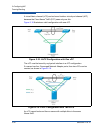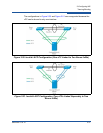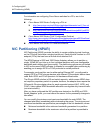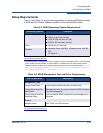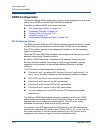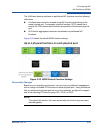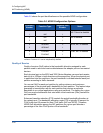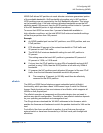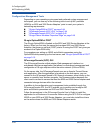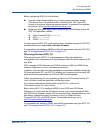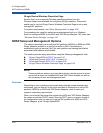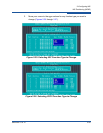
2–Configuring NIC
NIC Partitioning (NPAR)
2-42 SN0054671-00 B
Table 2-5 shows the port identifications and the possible NPAR configurations.
Quality of Service
Quality of service (QoS) refers to the bandwidth allocation assigned to each
partition used to send and receive data between the adapter port and connected
devices.
Each physical port on the 8200 and 3200 Series Adapters can send and receive
data at up to 10Gbps in both directions at the same time. When the physical port
is partitioned into four partitions, the port bandwidth is divided between each port
partition according to traffic demands.
You can set QoS for each port partition by setting minimum and maximum
percentages of the physical port's bandwidth for each partition. This feature helps
guarantee a transmission rate for each partition that requires a particular
bandwidth to run critical applications using port partitions. The setting for a given
QoS can resolve bottlenecks that exist when virtual machines (VMs) contend for
port bandwidth.
Enhanced transition selection (ETS) controls the actual bandwidth allocation at
the network port. The bandwidth allocation under ETS is typically 50 percent for
FCoE traffic and 50 percent for Non-FCoE traffic (NIC and iSCSI). Therefore,
NPAR QoS allocations among the NIC partitions for a given port allocate a
percentage of the Non-FCoE portion of the bandwidth.
Table 2-5. NPAR Configuration Options
Function
Number
Function Type
Physical Port
Number
Notes
0 NIC 0 Always present. Always
NIC. Cannot be disabled.
1 NIC 1
2 NIC 0 NIC or disabled
3NIC 1
4 iSCSI/NIC 0 iSCSI, NIC, or disabled
5 iSCSI/NIC 1
6 FCoE/NIC 0 FCoE, NIC, or disabled
7 FCoE/NIC 1
Only one iSCSI and/or FCoE function per physical port. NIC, iSCSI, and FCoE have fixed function
numbers. Functions 2–7 can be independently disabled.




